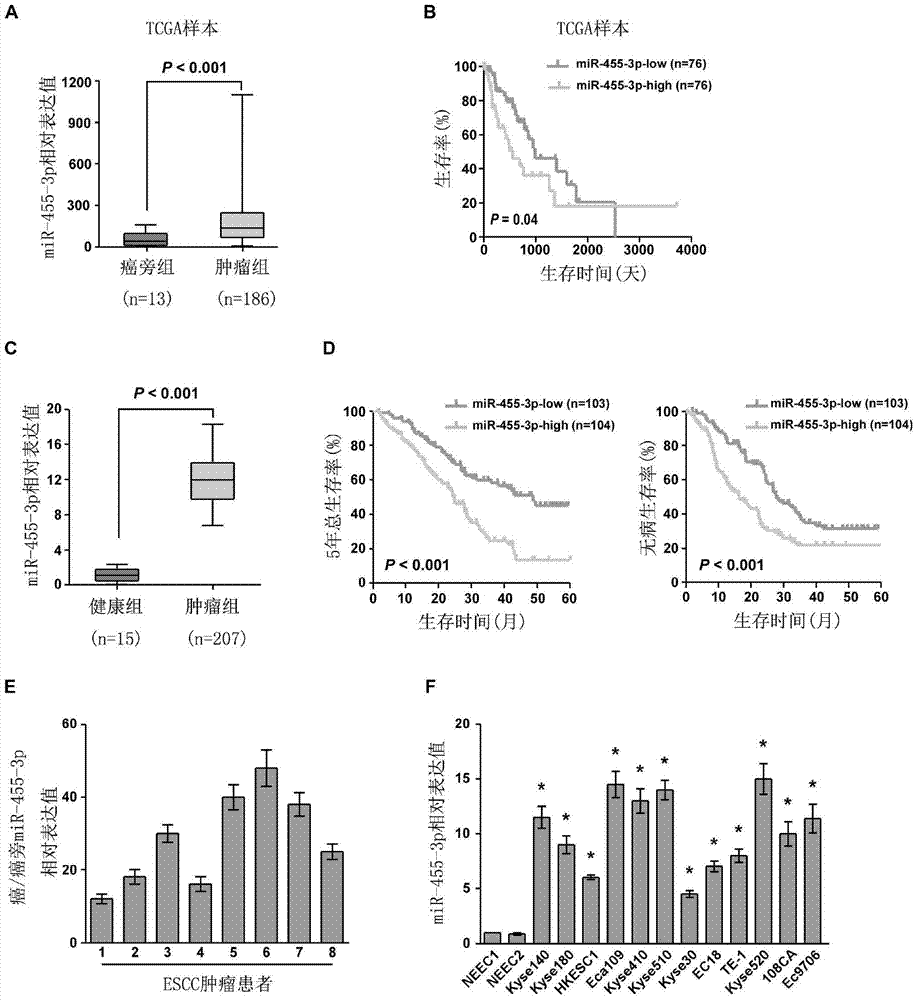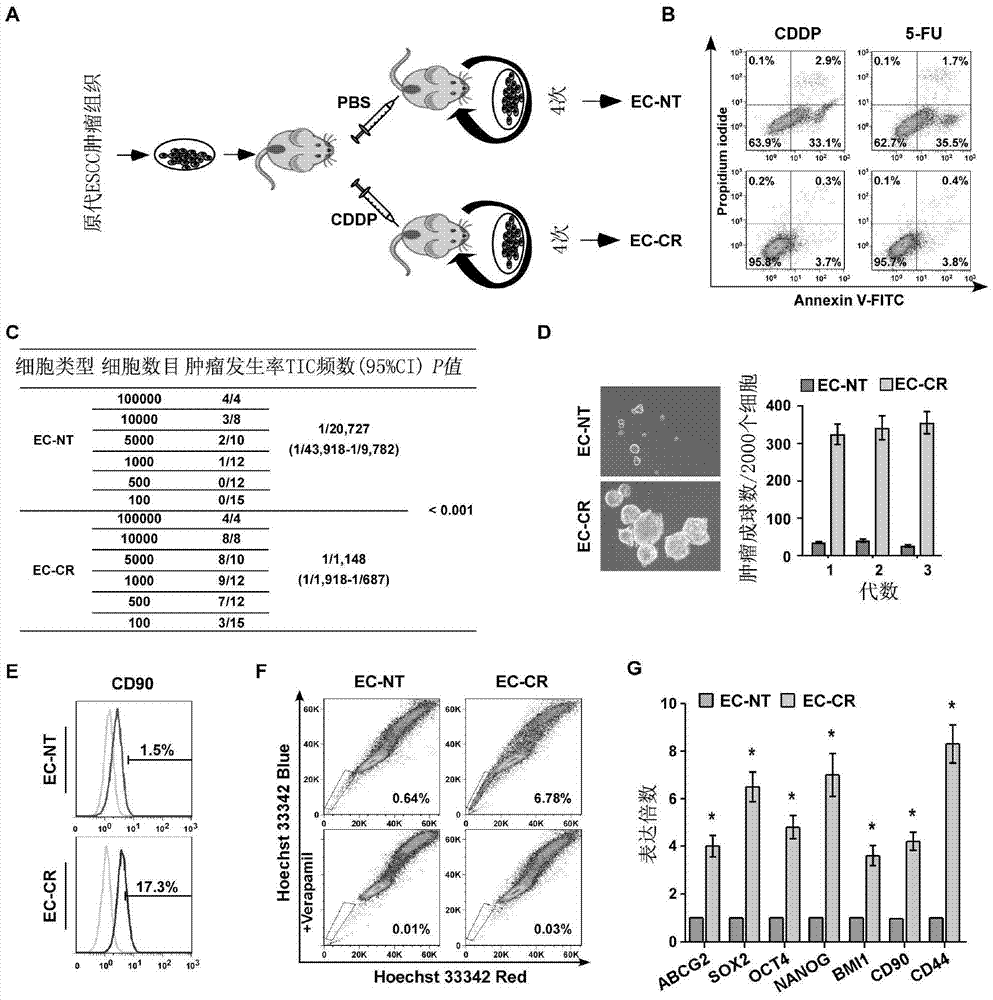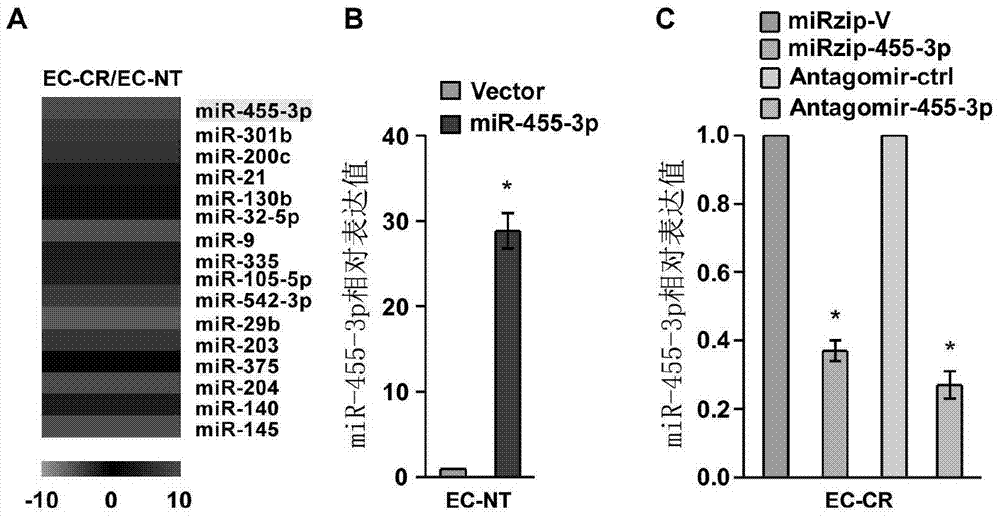Application of mir‑455‑3p in the diagnosis, treatment and prognosis of esophageal squamous cell carcinoma
A technology for esophageal squamous cell carcinoma, applied in gene therapy, medical preparations containing active ingredients, biochemical equipment and methods, etc., can solve problems such as difficulty in killing tumor stem cells
- Summary
- Abstract
- Description
- Claims
- Application Information
AI Technical Summary
Problems solved by technology
Method used
Image
Examples
Embodiment 1
[0040] Example 1 miR-455-3p is upregulated in ESCC samples
[0041] (1) TCGA database analysis
[0042] Methods: Using SPSS statistical analysis method, the expression level of miR-455-3p and its relationship with survival rate were analyzed in 186 ESCC patients and 13 ESCC paracancerous tissues in The Cancer Genome Altas Project (TCGA). All statistical analyzes were processed with SPSS17.0 statistical software. Values are expressed as mean ± SD, P <0.05 was considered a statistically significant difference.
[0043] The analysis results showed that the expression of miR-455-3p in ESCC tumor tissue was significantly higher than that in paracancerous tissue samples ( P figure 1 -A); define the expression of miR-455-3p in ESCC tumor tissue exceeding the median expression, called miR-455-3p high expression; ESCC tumor tissue miR-455-3p expression lower than the median expression, called miR-455-3p low expression, from figure 1 In -B, it can be seen that the high expressi...
Embodiment 2
[0053] Example 2 Construction of ESCC tumor cell lines resistant and sensitive to chemotherapeutic drugs
[0054] (1) Establishment of drug-resistant strains and non-drug-resistant strains
[0055] Methods: The tumor cells of ESCC patients were subcutaneously inoculated into NOD / SCID mice (4–5 weeks old, 18-20g), and one week later, the mice were intraperitoneally injected with PBS buffer or 5mg / kg cis-diamine Chloroplatinum (CDDP), twice a week for 4 weeks. Afterwards, the ESCC tumor cells in the mice were isolated and cultured on a plate, and the above steps were repeated 3 times. The mouse tumor cells after the fourth inoculation were isolated and cultured on a plate. The ESCC tumor cells obtained in the CDDP group were CDDP-treated ESCC strains (hereinafter referred to as EC-CR), and those in the PBS group were non-CDDP-treated ESCC strains (hereinafter referred to as EC-CR). EC-NT) (see 2-A). EC-CR and EC-NT cells were treated with chemotherapeutic drugs cis-diamminodi...
Embodiment 3
[0074] Example 3 Construction of miR-455-3p stable high expression and inhibited expression cells
[0075] (1) microRNA associated with ESCC tumor stem cells
[0076] Using microRNA expression profile analysis to detect the expression of microRNA in EC-CR and EC-NT cells, it was found that miR-455-3p was highly expressed in EC-CR and EC-NT cells, and the expression of miR-455-3p in EC-CR The expression level is higher than that of EC-NT (see image 3 -A).
[0077] (2) Construction of stable cells with high expression of miR-455-3p
[0078] ESCC cells EC-NT were cultured in DMEM medium (DMEM; Gibco) supplemented with 10% fetal bovine serum (Gibco) in a carbon dioxide incubator at 37°C.
[0079] 1) Construct the overexpression plasmid of miR-455-3p
[0080] The full-length mRNA sequence of miR-455-3p, UCCCUGGCGUGAGGGUAUGUGCCUUUGGACUACAUCGUGGAAGCCAGCACCAUGCAGUCCAUGGGCAUAUACACUUGCCUCAAGGCCUAUGUCAUC (SEQ ID NO: 5), was amplified by PCR.
[0081] The primer sequences are as fol...
PUM
 Login to View More
Login to View More Abstract
Description
Claims
Application Information
 Login to View More
Login to View More - R&D
- Intellectual Property
- Life Sciences
- Materials
- Tech Scout
- Unparalleled Data Quality
- Higher Quality Content
- 60% Fewer Hallucinations
Browse by: Latest US Patents, China's latest patents, Technical Efficacy Thesaurus, Application Domain, Technology Topic, Popular Technical Reports.
© 2025 PatSnap. All rights reserved.Legal|Privacy policy|Modern Slavery Act Transparency Statement|Sitemap|About US| Contact US: help@patsnap.com



